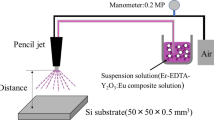Abstract
To fabricate thick-walled hollow glass microspheres (HGMs) for inertial confinement fusion (ICF) targets by sol-gel technology, we investigated the effects of glass composition, blowing agent, refining temperature, pressure and composition of furnace atmosphere on the wall thickness of HGMs by numerical simulation and experiments. The results showed that the residence times of the thick-walled HGMs in the encapsulating and refining phases decreased with the increase of wall thickness of HGMs. As a response to this challenge, glass composition must be optimized with the object of high surface tension and low viscosity at refining temperature, and the blowing agents with high decomposition temperature should be used, furthermore the concentration of blowing agents in gel particles must also be precisely controlled. The higher volume fraction of argon gas in the furnace atmosphere, the thicker the wall of HGMs. Due to the limited operating range of furnace atmosphere pressure, changing furnace atmosphere pressure could not significantly increase the wall thickness of HGMs. Although increasing refining temperature can improve the yield of high quality HGMs, a higher furnace atmosphere temperature may lead to a decrease in the wall thickness of HGMs. When the volume fraction of argon gas in the furnace atmosphere ranged from 80% to 95%, the furnace atmosphere pressure ranged from 1.0×105 Pa to 1.25×105 Pa, and the refining temperature ranged from 1600°C to 1800°C, we produced thick-walled (5–10 μm) HGMs with good sphericity, wall thickness uniformity and surface finish. However, the yield of high quality HGMs needs to be further improved. The compressive strength, tensile strength and permeation coefficient to deuterium gas of thick-walled HGMs at ambient temperature decreased with increase of the wall thickness.
Similar content being viewed by others
References
Tang Y J. Investigation on inertial confinement fusion (ICF) target (in Chinese). Trends Nucl Phys, 1995, 12(4): 50–53
Bono M, Bennett D, Castro C, et al. Fabrication of double shell targets with a glass inner capsule supported by SiO2 aerogel for shots on the omega laser in 2006. Fusion Sci Technol, 2007, 51(4): 611–625
Qiu L H, Tang Y J, Wei Y, et al. Hollow glass microsphere production for laser direct-driven fusion targets on Shen Guang II. Sci China Ser A-Math, 2002, 45(3): 371–377
Qi X B, Tang Y J, Li B, et al. Fabrication of hollow glass microspheres used for ICF targets by dried-gel method (in Chinese). Higher Power Laser Part Beams, 2006, 18(1): 55–60
Hoppe M L. Large glass shells from GDP shells. Fusion Technol, 2000, 38(1): 42–45
Nikroo A, Steinman D A. Thin sputtered glass as a permeation barrier for plasma polymer shells. Fusion Technol, 1999, 35: 212–215
Qiu L H, Wei Y, Tang Y J, et al. Analysis on the formation process of hollow glass microspheres fabricated by liquid droplet method (in Chinese). Atom Energy Sci Technol, 2001, 35(1): 60–64
Hoppe M L, Steinman D A. New developments in glass shells from SiGDP-residual gases, gas filling and tailored half-lives. Fusion Sci Technol, 2007, 51(4): 606–610
Qi X B, Wei S, Zhang Z W, et al. Fabrication process of hollow glass microspheres by sol-gel technology (in Chinese). Atom Energy Sci Technol, 2010, 44(11): 1371–1375
Qi X B, Zhang Z W, Li B, et al. Simulation of fabrication process of hollow glass microspheres by sol-gel technology (in Chinese). Chin J Process Eng, 2010, 10(1): 109–114
Qi X B, Wei S, Zhang Z W, et al. Effects of furnace atmosphere composition on fabrication process of hollow glass microspheres in drop-tower furnace (in Chinese). Higher Power Laser Part Beams, 2010, 22(7): 1543–1547
Qi X B, Li B, Chen S F, et al. Effects of furnace atmosphere pressure on fabrication process of hollow glass microspheres in drop-tower furnace (in Chinese). Atom Energy SciTechnol, 2010, 44(9): 1065–1070
Qi X B, Tang Y J, Li B, et al. Composition design of hollow glass microsphere for ICF experiment (in Chinese). Glass Enamel, 2005, 33(6): 34–40
Qi X B, Li B, Chen S F, et al. Preparation of large-diameter hollow glass microspheres with dried gel method for inertial confinement fusion targets (in Chinese). J Chin Ceram Soc, 2010, 38(4): 718–724
Campbell J H, Grens J Z, Poco J F. Preparation and Properties of Hollow Glass Microspheres. UCRL-53516, Livermore: Lawrence Livermore National Laboratory, 1983: 8
Zhang Z W, Li B, Tang Y J, et al. Influence of wall thickness and filling gas procedure on permeability of hollow glass microsphere (in Chinese). Higher Power Laser Part Beams, 2006, 18(6): 957–960
Author information
Authors and Affiliations
Corresponding author
Rights and permissions
About this article
Cite this article
Gao, C., Qi, X., Wei, S. et al. Production of thick-walled hollow glass microspheres for inertial confinement fusion targets by sol-gel technology. Sci. China Technol. Sci. 54, 2377–2385 (2011). https://doi.org/10.1007/s11431-011-4457-2
Received:
Accepted:
Published:
Issue Date:
DOI: https://doi.org/10.1007/s11431-011-4457-2




